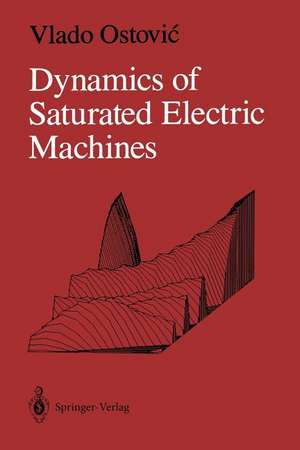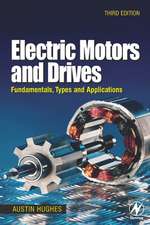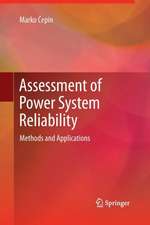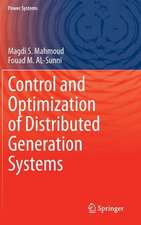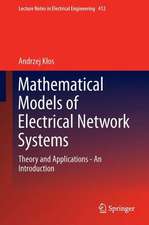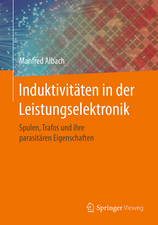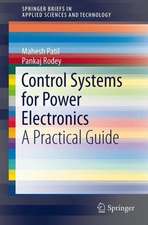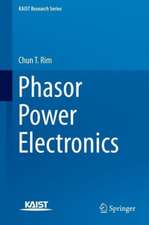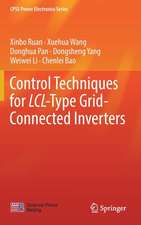Dynamics of Saturated Electric Machines
Autor Vlado Ostovicen Limba Engleză Paperback – 10 noi 2011
Preț: 648.56 lei
Preț vechi: 763.01 lei
-15% Nou
Puncte Express: 973
Preț estimativ în valută:
124.11€ • 132.71$ • 103.47£
124.11€ • 132.71$ • 103.47£
Carte tipărită la comandă
Livrare economică 17 aprilie-01 mai
Preluare comenzi: 021 569.72.76
Specificații
ISBN-13: 9781461389354
ISBN-10: 1461389356
Pagini: 464
Ilustrații: XIII, 445 p.
Dimensiuni: 155 x 235 x 24 mm
Greutate: 0.64 kg
Ediția:Softcover reprint of the original 1st ed. 1989
Editura: Springer
Colecția Springer
Locul publicării:New York, NY, United States
ISBN-10: 1461389356
Pagini: 464
Ilustrații: XIII, 445 p.
Dimensiuni: 155 x 235 x 24 mm
Greutate: 0.64 kg
Ediția:Softcover reprint of the original 1st ed. 1989
Editura: Springer
Colecția Springer
Locul publicării:New York, NY, United States
Public țintă
ResearchCuprins
1 Introduction.- 2 Magnetic Circuits.- 2.1 Analogies Between Electric and Magnetic Circuits.- 2.2 Permeances in Magnetic Circuits.- 2.3 Sources in Magnetic Circuits.- 2.4 Force and Torque.- 2.5 Magnetic Equivalent Circuits of Electromagnetic Devices.- 2.6 Magnetic Equivalent Circuit Solution Procedure.- 3 Winding Transform Matrices.- 3.1 Winding Topology Matrix.- 3.2 Number of Turns per Coil Matrix.- 3.3 Coil Currents Matrix.- 3.4 Slot Ampere-Turns Matrix.- 3.5 Tooth Magnetomotive Force Matrix.- 3.6 Magnetomotive Force Transform Matrix w?.- 3.7 Coil Flux Matrix.- 3.8 Number of Turns per Elementary Phase Matrix.- 3.9 Elementary Phase Flux Matrix.- 3.10 Flux Transform Matrix w?.- 3.11 Summary of Winding Transform Matrices.- 3.12 Squirrel Cage Connection Matrices.- 4 Extended System of Machine Algebraic Equations.- 4.1 Squirrel Cage Induction Machine — A Simple Model.- 4.2 Squirrel Cage Induction Machine — A Complex Model.- 4.3 Wound Rotor Synchronous Machine.- 4.4 Permanent Magnet Synchronous Machine.- 4.5 Stepper and Switched Reluctance Motor.- 4.6 Shaded Pole Induction Motor.- 5 Machine System of Differential Equations and Complete System of Algebraic Equations.- 5.1 Stator Differential Equations of an A.C. Machine.- 5.2 Rotor Differential Equations of an A.C. Machine.- 6 Unique System of Machine Equations.- 6.1 Influence of Series-Added Impedance.- 6.2 k-Winding, n-Limb Transformer.- 6.3 Induction Machine — a Simple Model.- 6.4 Squirrel Cage Induction Machine — a Complex Model.- 6.5 Wound Rotor Synchronous Machine.- 6.6 Permanent Magnet Synchronous Machine.- 6.7 Step and Switched Reluctance Motor.- 6.8 Shaded Pole Induction Machine.- 6.9 Initial Conditions Definition.- Appendix I - Matrix Operators.- Appendix II - Vector and Matrix Differentiation.-Appendix III - Applications.- III.1. Squirrel Cage Induction Machine.- III.1.1 Starting Characteristics of the Basic Machine.- III.1.2 Basic Machine with Additional Inertia on the Shaft.- III.1.3 Basic Machine with a Decreased Number of Rotor Slots and an Additional Inertia on the Shaft.- III.1.4 Basic Machine with Linear B-H Curve and Additional Inertia.- III.1.5 Wye-Connected Basic Machine with Additional Inertia.- III.1.6 Reversing of the Basic Machine with Additional Inertia.- III.1.7 Basic Machine with Blocked Rotor.- III. 1.8 Basic Machine with Full Pitch Stator Winding and Additional Inertia.- III.1.9 Wye-Connected Basic Machine with 4/6 Winding Pitch.- III.1.10 Basic Machine with Unskewed Rotor and Additional Inertia.- III.1.11 Unsymmetric Connection of the Basic Machine.- III.1.12 Basic Machine in Steinmetz Connection.- III.1.13 Basic Machine with Additional Inertia Fed from a Six-Step Voltage Source Inverter.- III.1.14 Wye-Connected Basic Machine with Additional Inertia Fed from a Six-Step Voltage Source Inverter.- III.1.15 Basic Machine with Additional Inertia Fed from a Current Source.- III.1.16 Capacitor Braking of the Basic Machine.- III.1.17 D.C. Current Braking of the Basic Machine.- III.2. Permanent Magnet Synchronous Machine.- III.2.1 Starting of the Basic Machine without Permanent Magnets.- III.2.2 Starting of the Basic Machine.- III.2.3 Loading of the Basic Machine.- III.2.4 Heavy Loading — Loss of Synchronism.
